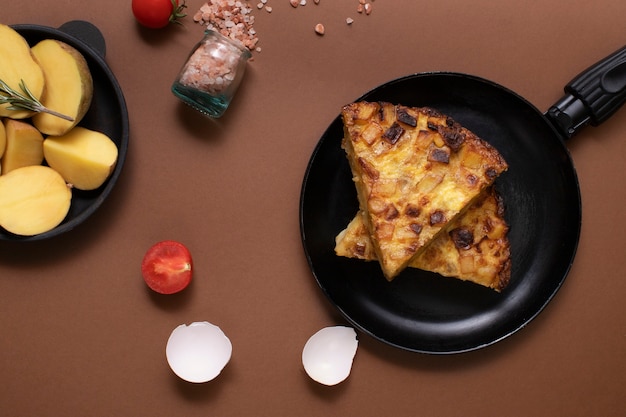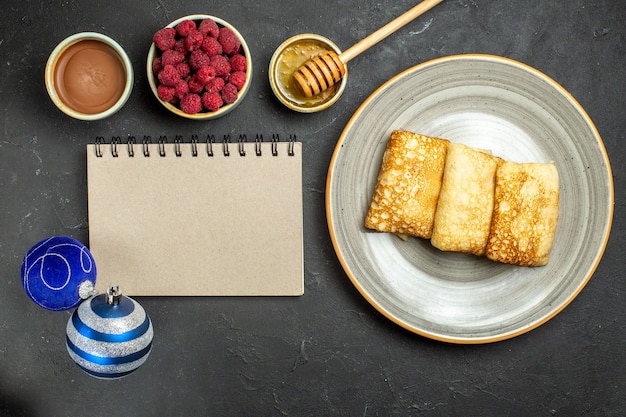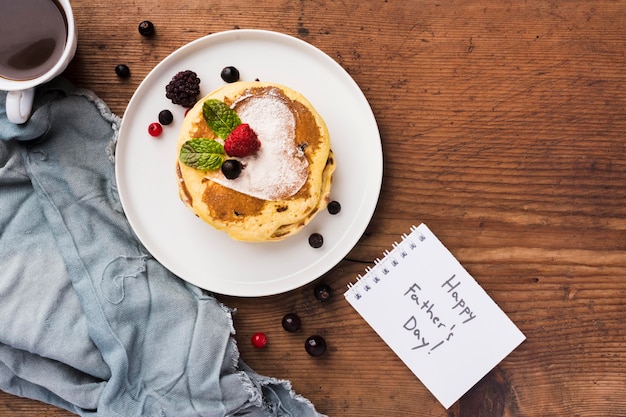There's something undeniably charming about pancakes. The aroma of warm batter, the delightful sizzle on a hot pan, the golden-brown hues, and the anticipation of devouring a fluffy stack with a generous drizzle of syrup – it all adds up to pure culinary bliss. But achieving that perfect pancake is more than just a good recipe; it's about finding the sweet spot when it comes to temperature. Trust me, I've learned this the hard way through countless burnt and undercooked pancake disasters. I've spent years in the kitchen, experimenting, tweaking, and perfecting my pancake game, and I'm here to share my secrets for achieving that glorious, golden brown pancake, every single time.
(Part 1) Unlocking the Secrets of pancake science

While I wouldn't call myself a scientist, I've definitely done my fair share of kitchen experiments. And I've discovered that understanding the science behind a good pancake is crucial to getting those perfect results. It all boils down to how heat interacts with the batter. Think of pancakes as a delicate dance between the gluten in the flour, the sugars, and the liquids. When you heat the pan, the gluten starts to develop, creating the framework for the pancake. If the temperature is too low, you'll end up with a dense, doughy pancake. Too high, and you'll be left with a burnt mess. The aim is to find that sweet spot where the pancake cooks evenly through, achieving that beautiful golden brown exterior while retaining its fluffy and tender interior.
The Power of Temperature
Imagine trying to bake a cake in a cold oven. It simply won't cook properly, right? It's the same with pancakes. The pan needs to be hot enough to kickstart the chemical reactions that transform the batter into a delicious pancake. But it shouldn't be so hot that it scorches the surface before the inside has a chance to cook. This is where the art of temperature control comes in.
The Role of the Pan: Your Culinary Canvas
The pan itself is another crucial player in the pancake game. A good quality pan, like a cast iron skillet or a non-stick pan, will distribute heat evenly, preventing sticking and ensuring your pancakes cook consistently. For those who swear by cast iron, proper seasoning is key. Applying a thin layer of oil or fat before heating creates a non-stick surface and prevents your pancakes from clinging to the pan. This prevents sticking and creates a smooth, even cooking surface for your pancake artistry.
(Part 2) Finding the Golden Mean: The Temperature Sweet Spot

Now, let's get down to brass tacks. How do we find that perfect temperature? There are a couple of tried and true methods that every pancake enthusiast should have in their arsenal.
The Thermometer: Your Reliable Guide
For those who want a scientific approach, a trusty thermometer is your best friend. The ideal temperature range for pancakes is between 175-200°F (80-93°C). This ensures the batter cooks through without burning the surface. But let's be honest, sometimes the thermometer is just another kitchen gadget we forget to use. Fear not, there are other ways to gauge that perfect temperature.
The "Water Drop" Test: A Classic Trick
This is a classic method used by generations of cooks. It's simple and effective. Add a few drops of water to the pan. If the water sizzles and evaporates quickly, your pan is hot enough. If the water just sits there, it needs a little more heat. This method is a great visual indicator of the pan's heat.
The "Hand Test": A Hands-On Approach
This method involves using your own hand to judge the heat of the pan. Hold your hand a few inches above the pan. If you can feel the heat radiating, the pan is probably ready. If you can't feel any heat, it needs to be heated further. Just remember to be cautious and use your intuition!
(Part 3) The First Pancake: Your Culinary Test Run

Now that your pan is prepped and at the perfect temperature, it's time to pour that batter. But before you go flipping like a pro, let's talk about the first pancake. This is your test run, your opportunity to fine-tune the heat and ensure your pancake journey is a success.
The Telltale Signs of a Perfect First Pancake
A perfect first pancake should exhibit a few key characteristics. You'll see beautiful bubbles forming on the surface, indicating the heat is just right for cooking the batter through. The edges should start to turn a lovely golden brown, signifying that the pan is hot enough to create that crispy crust. If the edges are browning too quickly, the pan is too hot, and you'll need to reduce the heat slightly. If the batter doesn't bubble up at all, the pan isn't hot enough, and you'll need to increase the heat a little.
Adjusting the Heat: Your Kitchen Choreography
If the first pancake is a tad too dark, turn down the heat a notch. If it's not browning enough, crank up the heat slightly. Remember, it's all about finding that delicate balance, that sweet spot where the heat works in harmony with your batter.
(Part 4) The Flipping Point: A Moment of Culinary Truth
Ah, the flipping moment! This is a crucial step in the pancake-making process. You want to flip your pancake at the precise moment, ensuring it's cooked through without becoming dry and crispy. Flipping too early can result in a raw pancake, while flipping too late can lead to a burnt one.
The Signs of a Perfect Flip: Your Pancake's Cue
The pancake should have set on the bottom and feel slightly firm to the touch. You'll see tiny bubbles forming on the surface, and the edges will have begun to brown. If the pancake is still very liquidy, give it a few more minutes to set before attempting to flip.
The Art of the Flip: Graceful Precision
Flipping a pancake is a culinary dance, requiring a delicate touch and a steady hand. Use a thin spatula, gently slide it under the pancake, and lift it up. Flip it over smoothly, allowing it to land softly on the pan. If you're not confident in your flipping skills, use a wider pancake turner for more support. Practice makes perfect, and soon you'll be flipping like a pro.
(Part 5) The Second Side: Building the Foundation of Perfection
The second side of the pancake requires a bit less attention than the first. It's already cooked on one side, so it shouldn't take long to cook through on the other. However, you still need to keep a watchful eye.
The "Spot Test": Assessing Doneness
To check if the second side is done, gently press the top of the pancake with your spatula. If it springs back slightly, it's cooked through. You'll also notice a beautiful golden brown color developing on the second side.
The "Flip" Decision: A Second Chance
If the second side is browning too quickly, it's time to reduce the heat. If it's not browning enough, you can increase the heat a tad. Remember, the goal is to achieve that gorgeous golden brown hue on both sides without burning the pancake.
(Part 6) Stacking and Serving: Your Culinary Masterpiece
Once the pancake is cooked to perfection, it's time to remove it from the pan. Gently slide your spatula under the pancake and lift it up. Now, it's time to stack those beauties! There's something incredibly satisfying about a stack of pancakes, tall and proud, with a generous drizzle of syrup and a pat of butter. It's a culinary masterpiece, and you're the artist.
The Pancake Stack: An Artful Arrangement
When stacking your pancakes, make sure they are placed flat and even on top of each other. This prevents them from collapsing and creates a more aesthetically pleasing stack. It's about achieving that perfect balance of fluffy pancakes.
The Perfect Garnish: A Touch of Personal Flavor
The options for garnishing pancakes are endless. You can stick with the classics, like a drizzle of syrup and a pat of butter, or get creative with fresh fruit, chocolate chips, whipped cream, or a sprinkle of powdered sugar. It's your culinary canvas, so let your creativity soar.
(Part 7) Troubleshooting Pancake Problems: Solutions for Every Kitchen Challenge
Let's face it, even the most seasoned pancake chefs can encounter a few bumps in the road. But don't worry! We'll tackle those pancake problems together and emerge victorious.
Problem: Pancakes Stick to the Pan
Solution: Make sure your pan is well-seasoned and greased with a thin layer of butter or oil before cooking. If the pancakes are still sticking, try adjusting the heat. A pan that's too hot can cause the batter to stick. Lowering the heat slightly might do the trick.
Problem: Pancakes Are Too Thick
Solution: Try thinning out the batter by adding a bit more milk or water. You can also use a larger ladle to pour the batter onto the pan. The goal is for the batter to spread out evenly, creating a thin and fluffy pancake.
Problem: Pancakes Are Too Thin
Solution: You can try adding a bit more flour to the batter, but be careful not to overdo it. If you're using a recipe with a high liquid content, try adding a tablespoon of flour at a time until you achieve the desired consistency.
Problem: Pancakes Are Not Browning
Solution: Increase the heat of the pan to allow the pancake to brown properly. Make sure your pan is hot enough before pouring the batter. If you're using a low-heat pan, it might be time to invest in a new one. A good quality pan will help ensure even browning.
Problem: Pancakes Are Burnt
Solution: Reduce the heat of the pan immediately. If the pancake is already burnt, try scraping off the burnt bits with a spatula. Remember to keep a close eye on your pancakes and adjust the heat accordingly.
(Part 8) The pancake variations: Exploring culinary adventures
The world of pancakes is vast and exciting, with countless variations to explore. From savoury pancakes to decadent dessert pancakes, there's a pancake for every taste bud and every culinary whim. Let's embark on a journey of flavour.
Savoury Pancakes: A Twist on Tradition
These pancakes are a fantastic way to add a savoury flair to your breakfast or brunch. You can incorporate ingredients like cheese, herbs, bacon, or even vegetables to create a hearty and delicious meal.
- Cheese Pancakes: Add shredded cheddar, mozzarella, or parmesan cheese to your batter for a cheesy twist.
- Herb Pancakes: Incorporate chopped herbs like chives, parsley, or basil into your batter for a fresh and fragrant flavour.
- Bacon Pancakes: Fry some crispy bacon and add it to your batter or sprinkle it on top of the cooked pancakes.
- Vegetable Pancakes: Add chopped vegetables like spinach, zucchini, or mushrooms to your batter for a nutritious and flavorful pancake.
Sweet Pancakes: Indulge Your Sweet Tooth
These pancakes are perfect for satisfying your sweet tooth. You can add ingredients like chocolate chips, blueberries, or bananas to create a decadent dessert.
- Chocolate Chip Pancakes: Add chocolate chips to your batter for a delicious and indulgent treat.
- Blueberry Pancakes: Fold blueberries into your batter for a burst of fresh fruit flavour.
- Banana Pancakes: Mash ripe bananas and add them to your batter for a sweet and moist pancake.
- Maple Pecan Pancakes: Add chopped pecans to your batter and drizzle with maple syrup for a nutty and sweet pancake.
(Part 9) Beyond the Basics: Elevate Your Pancake Game
Now, let's go beyond the classic pancake recipe and explore some exciting variations that will take your pancake game to the next level.
pancake batter Alternatives: Experiment with Flavor
If you're looking to switch things up, there are plenty of alternative batter options to experiment with.
- Oatmeal Pancakes: Combine rolled oats with milk, eggs, and a little flour for a nutritious and flavorful pancake.
- Cornmeal Pancakes: Use cornmeal instead of flour for a slightly sweet and nutty pancake.
- Gluten-Free Pancakes: There are many gluten-free flour blends available that you can use to create delicious and satisfying pancakes.
pancake toppings: A Symphony of Flavors
The possibilities for pancake toppings are endless. Don't be afraid to get creative and experiment with different flavours and textures.
- Fresh Fruit: Berries, bananas, kiwi, or peaches add a vibrant flavour and a burst of freshness to your pancakes.
- Whipped Cream: A dollop of whipped cream adds a touch of indulgence and a creamy texture to your pancakes.
- Chocolate Sauce: A drizzle of chocolate sauce is the perfect way to satisfy your sweet tooth.
- Nuts and Seeds: Toasted nuts and seeds like pecans, walnuts, or pumpkin seeds add a crunchy texture and a nutty flavour.
- Caramel Sauce: A drizzle of caramel sauce adds a rich and buttery sweetness to your pancakes.
- Ice Cream: Serve your pancakes with a scoop of ice cream for a decadent and indulgent treat.
(Part 10) Pancake Storage and Reheating: Preserving Your Culinary Creation
Let's talk about the best way to store and reheat your delicious pancakes. After all, sometimes you just can't resist the temptation of a second stack.
Storing Pancakes: Keeping Your Pancakes Fresh
To store pancakes, allow them to cool completely before placing them in an airtight container or wrapping them in plastic wrap. They can be stored in the refrigerator for up to 3 days.
Reheating Pancakes: Bringing Back the Flavor
There are a few ways to reheat pancakes and bring back their warmth and deliciousness.
- Microwave: Microwave pancakes on high for 15-20 seconds, or until heated through. Just be careful not to overcook them in the microwave, as they can become rubbery.
- Toasted: Place pancakes in a toaster or toaster oven and toast until lightly browned and crispy. This method adds a delightful crunch to your pancakes.
- Pan-Fried: Heat a skillet over medium heat and place pancakes in the skillet for 1-2 minutes per side, or until heated through. This method is ideal for restoring the fluffy texture and warming them evenly.
FAQs: Addressing Common Pancake Concerns
1. What if my pancakes are still raw in the middle?
If your pancakes are still raw in the middle, it's likely that the pan was not hot enough. To fix this, increase the heat of the pan and allow it to heat up for a few minutes before pouring the batter. You can also try cooking the pancakes for a longer time on the first side.
2. Why are my pancakes tough and dry?
Tough and dry pancakes are usually a sign of overcooking. Try cooking them for a shorter time on each side. Also, check the batter to make sure it's not too thick, which can lead to dryness.
3. Why are my pancakes flat and thin?
Flat and thin pancakes can be caused by a few things. First, make sure the pan is hot enough. If the pan is too cold, the batter won't cook evenly and will spread out too much. You can also try adding a tablespoon of melted butter or oil to the batter, which can help make them thicker and fluffier.
4. What is the best type of pan for making pancakes?
A good quality non-stick skillet or cast iron pan is ideal for making pancakes. Both types of pans distribute heat evenly and prevent sticking. If you're using a cast iron pan, make sure it's properly seasoned before cooking.
5. Can I use a different type of flour for making pancakes?
Absolutely! You can use different types of flour for making pancakes, such as oat flour, cornmeal, or even a gluten-free flour blend. Just adjust the amount of liquid in the batter accordingly, as different flours absorb liquid differently.
There you have it, the ultimate guide to pancake perfection! With these tips and tricks, you'll be a pancake pro in no time. So, gather your ingredients, grab your spatula, and get ready to create a culinary masterpiece. From breakfast to brunch to dessert, pancakes are a delicious and versatile treat that can be enjoyed in countless ways. Now, go forth and create your own pancake magic!
Everyone is watching

How to Cook Frozen Lobster Tails Perfectly: A Step-by-Step Guide
RecipesLobster. Just the word conjures up images of lavish meals, special occasions, and a taste of luxury. But let's...

Pigs in a Blanket Cooking Time: How Long to Bake for Perfect Results
RecipesAh, pigs in a blanket. Just the name conjures up images of those delightful little parcels of crispy pastry en...

Pork Fillet Cooking Time: How Long to Cook It Perfectly
RecipesPork fillet, or tenderloin as it's sometimes called, is a real favourite in our house. It's so versatile, and...

The Ultimate Guide to Cooking Delicious Frankfurters
RecipesLet's face it, we all love a good frankfurter. It's a classic, simple, and always satisfying. But let's be rea...

Wolf Meat Recipes: A Guide to Cooking Wild Game
RecipesLet's be honest, you don't see wolf meat at your local butcher shop every day. It's a bit of a wild card, but ...
